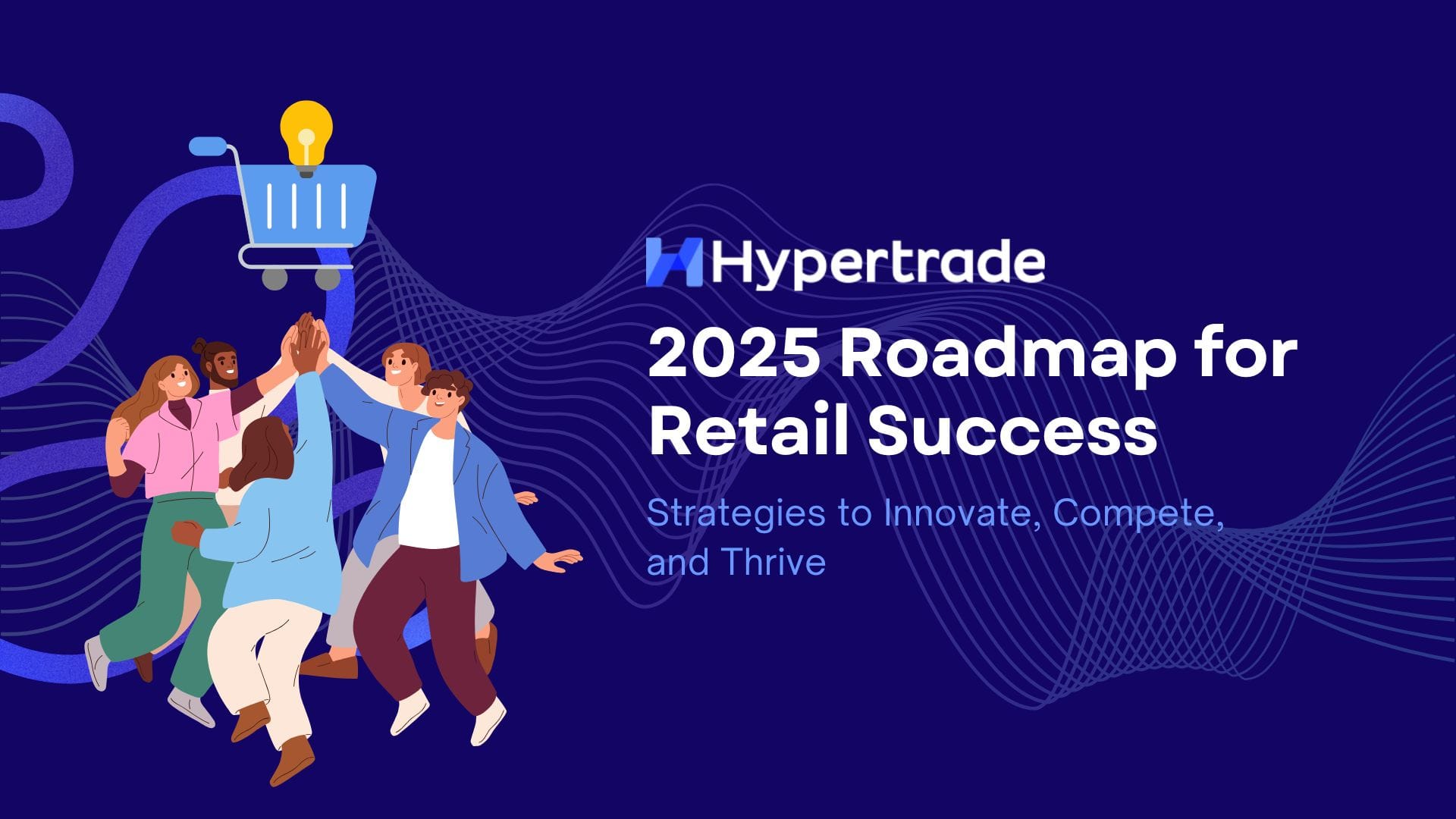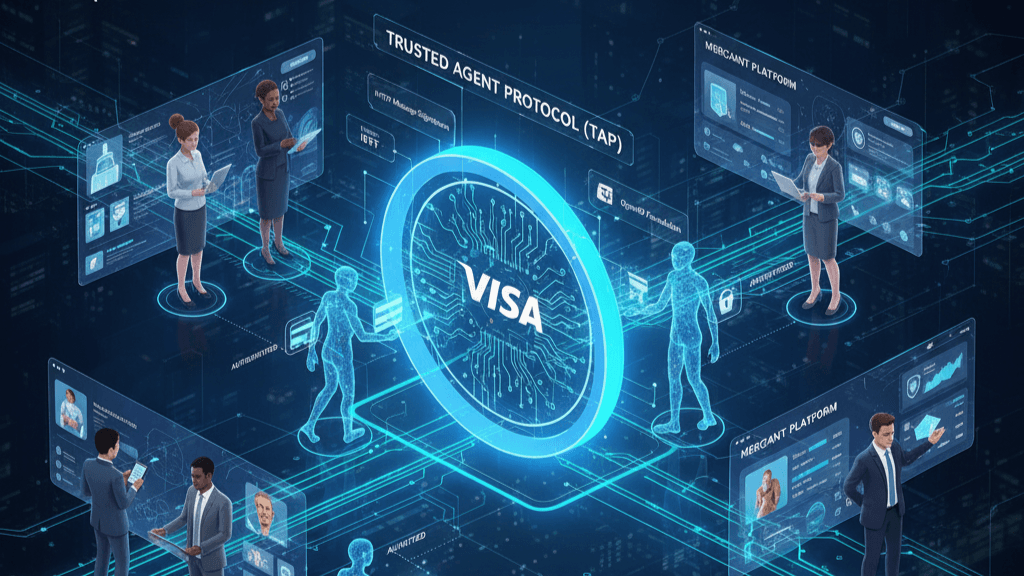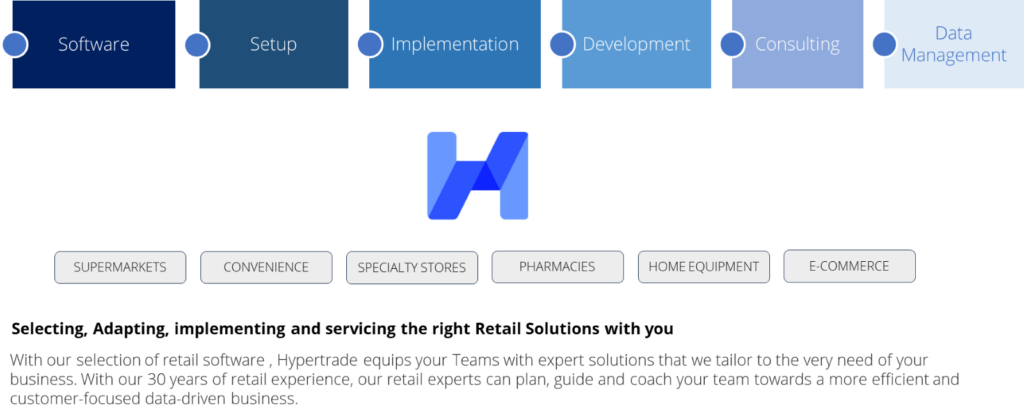Hypertrade has been at the forefront of the Retail Industry, driving Innovation and Excellence for 20 years. We are excited to share our insights and strategies for achieving retail success in the coming year. This roadmap outlines key areas that retailers should focus on to navigate the dynamic landscape and thrive in 2025.
As we approach 2025, the retail industry faces a dynamic landscape filled with both challenges and opportunities. To navigate this environment successfully, retailers must focus on optimizing costs, exploring new revenue streams, enhancing employee experience, developing robust customer strategies, and leveraging business enablers. This roadmap outlines key strategies and statistics to guide retailers toward success in 2025.
1. Optimizing Costs
Automation & Process Improvements Automation is crucial for reducing labor costs and increasing efficiency. According to a McKinsey report, automation could save retailers up to 20% in operational costs by 2025. Implementing automated without altering Customer Experience, and AI-driven customer service can significantly streamline operations. For example, Walmart’s use of shelf-scanning robots has improved inventory accuracy and reduced labor costs.
Streamlining processes can significantly cut costs and improve efficiency. Lean management techniques, for example, can reduce waste and increase productivity by up to 40%. By identifying and eliminating non-value-added activities, using simple business process automation digital tools like Bizagi, UiPath or Blue prism, retailers can enhance operational efficiency. Toyota’s implementation of lean principles in its production processes has led to substantial cost savings and productivity gains. Success stories or Walmart, Ikea or Starbucks can be inspiring examples.
Inventory Effective inventory management can minimize overstock and stockouts. Retailers using advanced inventory management systems have seen a 30% reduction in inventory costs. Techniques such as just-in-time (JIT) inventory, demand forecasting using AI, and tools like Quick Predict and Q-Order with real-time inventory tracking can help maintain optimal stock levels. Zara, for instance, uses a responsive inventory system that allows it to quickly adapt to changing fashion trends.
Assortment Data-driven assortment planning helps meet customer demands. Retailers leveraging big data for assortment planning have experienced a 15% increase in sales. By analyzing customer preferences and purchasing patterns, retailers can curate product assortments that resonate with their target audience. Tools like Hypertrade’s Ariane4S make it simple and extremely fast. Target’s use of predictive analytics to tailor its product offerings has resulted in higher customer satisfaction and increased sales.
Pricing Dynamic pricing strategies can keep retailers competitive. A study by Deloitte found that dynamic pricing can boost revenue by up to 10% and have an even stronger impact on the bottom line.. Utilizing AI and machine learning with tools like Booper, retailers can adjust prices in real-time based on demand, competition, and other market factors. Amazon’s dynamic pricing model, which changes prices multiple times a day, has been instrumental in maintaining its competitive edge.
Breakage Reducing product breakage and loss is essential. Implementing better handling and packaging techniques can reduce breakage by 25%. Investing in durable packaging materials, training staff on proper handling procedures, and using IoT sensors to monitor product conditions during transit can help minimize losses. Coca-Cola’s use of smart packaging to monitor product integrity during shipping has significantly reduced breakage rates.
2. Exploring New Revenue Streams
Data Collaboration Sharing data with partners can create new opportunities. Retailers collaborating on data initiatives have seen a 20% increase in revenue. By pooling data with suppliers and other partners, retailers can gain deeper insights into consumer behavior and market trends. Ariane Data Collaboration Platform is simple to setup and even easier to use. For instance, Kroger’s data collaboration with its suppliers has enabled more effective marketing campaigns and product placements.
Retail Media Retail media networks are becoming a significant revenue source. The retail media market is expected to grow by 25% annually, reaching $100 billion by 2025. Retailers can monetize their digital platforms by offering advertising space to brands. Walmart Connect, Walmart’s retail media network, has generated substantial revenue by allowing brands to advertise on its website and app.
Marketplace Expanding into online marketplaces can drive sales. Retailers on marketplaces like Amazon have reported a 30% increase in sales. By listing products on popular marketplaces, retailers can reach a broader audience and benefit from the platform’s established customer base. Nike’s partnership with Amazon has significantly boosted its online sales and brand visibility.
Social Commerce social media is a powerful sales driver. Social commerce sales are projected to reach $1.2 trillion by 2025. Leveraging platforms like Instagram, Facebook, and TikTok, retailers can engage with customers and drive sales through shoppable posts and live-streaming events. Sephora’s use of Instagram Shopping has enhanced its customer engagement and increased online sales.
Sustainable Commerce Sustainability attracts eco-conscious consumers. 70% of consumers are willing to pay more for sustainable products. Retailers can capitalize on this trend by offering eco-friendly products and adopting sustainable practices. Patagonia’s commitment to environmental sustainability has resonated with consumers, leading to increased brand loyalty and sales.
3. Enhancing Employee Experience
Personalized Experience Tailoring experiences to individual employee needs boosts satisfaction. Companies offering personalized employee experiences see a 21% increase in productivity. Providing flexible work schedules, personalized career development plans, and wellness programs can enhance employee engagement. Google’s personalized employee benefits program has contributed to high employee satisfaction and retention rates. It reminds us an old Carrefour (and probably other retailers as well) fundamental that said “Never forget your employees should be the first Customers of your store”.
Digital Tools for Collaboration Digital tools improve teamwork and communication. Organizations using collaboration tools report a 20% increase in employee engagement. Platforms like TRF Retail, Hypertrade’s Ariane, Microsoft Teams, Slack, and Zoom facilitate seamless communication and collaboration among remote and in-office employees. Microsoft’s use of Teams has improved collaboration and productivity across its global workforce.
Responsible Use of AI Ethical AI use is crucial. 60% of employees prefer working for companies that use AI responsibly. Implementing AI with transparency and fairness can build trust and enhance employee morale. IBM’s AI ethics guidelines ensure that AI applications are developed and used responsibly, fostering a positive work environment.
Agile Leadership Flexible leadership is key. Agile leadership practices can improve employee retention by 15%. Leaders who embrace agility can quickly adapt to changes and empower their teams to innovate. Spotify’s agile leadership model has enabled it to stay ahead in the competitive music streaming industry.
4. Customer Strategies
Building Customer Strategies Developing effective customer strategies is foundational. Companies with strong customer strategies see a 20% increase in customer satisfaction. Understanding customer needs and preferences through data analytics can help tailor marketing and service efforts. Starbucks’ customer loyalty program, driven by data insights, has significantly enhanced customer satisfaction and retention.
Personalization Personalized customer experiences are vital. Personalization can increase sales by 10%. Using AI and machine learning, retailers can offer personalized product recommendations and marketing messages. Netflix’s personalized content recommendations have been key to its subscriber growth and retention.
Eco-friendly Products Demand for sustainable products is rising. 80% of consumers prefer eco-friendly products. Offering products made from sustainable materials and promoting eco-friendly practices can attract environmentally conscious customers. IKEA’s commitment to sustainability, including its use of renewable materials, has strengthened its brand reputation and customer loyalty.
Influencer Marketing Influencers significantly impact consumer behavior. Influencer marketing can yield an 11x return on investment. Partnering with influencers who align with the brand’s values can enhance credibility and reach. Glossier’s or Sephora’s collaboration with beauty influencers has driven significant traffic and sales to its online store.
Digital Payments Digital payment options are essential. 75% of consumers prefer digital payments. Offering a variety of secure digital payment methods, such as mobile wallets and contactless payments, can enhance the shopping experience. Apple’s integration of Apple Pay in its retail stores has streamlined the checkout process and improved customer satisfaction.
Mobile First Optimizing for mobile users is critical. Mobile commerce is expected to account for 72.9% of all e-commerce sales by 2025. Ensuring that websites and apps are mobile-friendly can enhance the shopping experience and drive sales. Alibaba’s mobile-first strategy has been instrumental in its dominance of the e-commerce market.
5. Business Enablers
Customer Experience Management Enhancing customer satisfaction is crucial. Effective customer experience management can increase customer loyalty by 20%. Using customer feedback and analytics to improve service and product offerings can enhance the overall customer experience. Disney’s focus on customer experience management has resulted in high levels of customer satisfaction and loyalty.
Employee Training & Development Continuous learning is beneficial. Employee training programs can increase productivity by 15%. Offering ongoing training and development opportunities can help employees stay updated with industry trends and skills. AT&T’s extensive employee training programs have equipped its workforce with the skills needed for the digital age.
Innovation & Experimentation Encouraging innovation and partnerships is key. Companies that foster innovation see a 25% increase in market share. Creating a culture that supports experimentation and collaboration with external partners can drive growth. Google’s innovation labs and partnerships with startups have led to the development of groundbreaking products and services.
Agility Being adaptable and responsive is essential. Agile businesses can respond to market changes 50% faster. Implementing agile methodologies and practices can help businesses stay competitive and resilient. Spotify’s agile approach to
Tech Infrastructure Robust tech infrastructure is necessary. Investing in technology can improve operational efficiency by 30%. Implementing cloud computing, IoT, and advanced analytics can enhance business operations. Amazon’s investment in cloud infrastructure through AWS has enabled it to scale efficiently and support its vast e-commerce operations.
Data Management & Security Protecting customer data is paramount. Companies with strong data security measures see a 25% reduction in data breaches. Implementing robust cybersecurity protocols and compliance measures can safeguard sensitive information. Equifax’s enhanced data security measures following its data breach have restored customer trust and improved security.
Sources:
Explore 2025 Retail Trends: Tech & Consumer Focus
2025 Retail Trends That Are Changing The Game | RetailNext
5 Essential Strategies to Help Retailers Thrive in 2025 | Retail Dive
Top 8 Retail Industry Trends in 2025 | StartUs Insights
Top 10 Retail Trends for 2025
Contact Us for a Consultation
Ready to take your retail business to the next level? Contact Hypertrade today for a personalized consultation and discover how our expertise can help you achieve success in 2025 and beyond.







